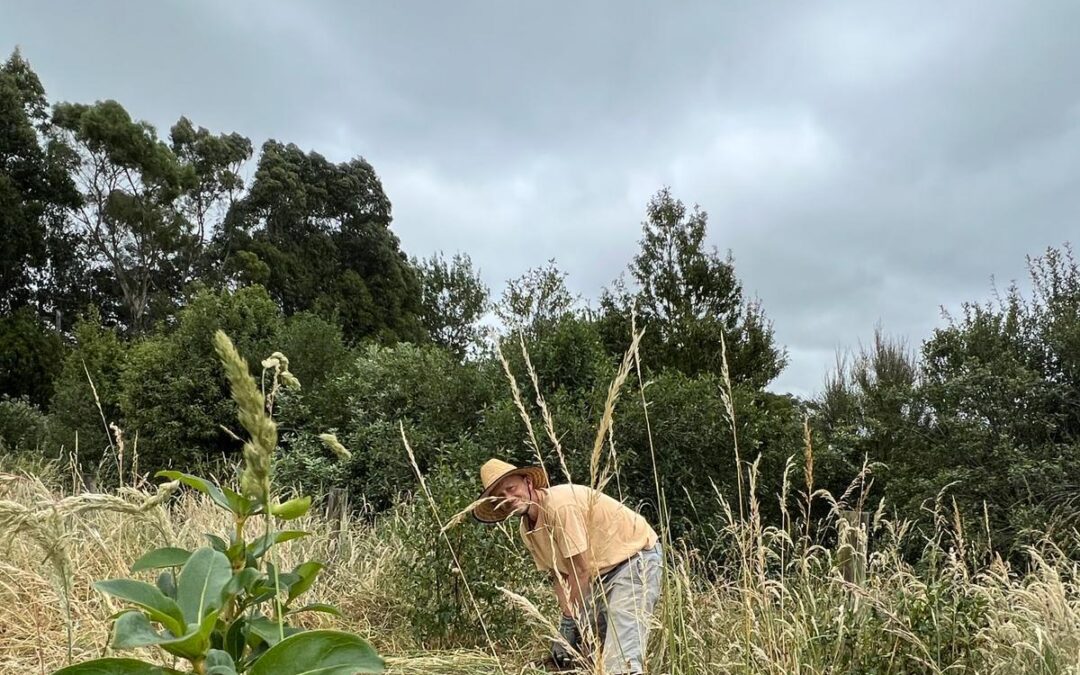Words by Jane Riddiford
At first it’s depressing and disheartening; “It can’t be, something must have survived,” I think. My pace slows and now in detective mode I scan the long grasses with more intent. Barely distinguishable from the brown reeds and grasses, I see a tell-tale sign that somebody has been there; the end of a small bamboo cane, poking through the grass. Carefully now I pull back the long mat of grasses hoping for a find. Next comes a corner of wool matting and a little cardboard. Will it be dead or alive, I wonder. Suddenly it comes into view. A long leafy stem woven and almost cocooned into the surrounding vegetation. As I carefully pull the grasses apart, a small sapling bounces upright.

All morning it was the same, apparently nothing and then one after another something. Sometimes all I found was an old root ball or a dried out stem with a tiny leaf or two; maybe just enough to carry it through the summer. All the while I am wondering about balance. Perhaps the long pasture grass has protected the young trees from the drying effect of the sun and the harsh winds, along with offering protection from the possums, hares and rabbits that roam the valley. Who knows how long the saplings could have survived bent over like that before the grass swamped and overwhelmed them.
A sharp niwashi tool is a big help in clearing back the grass. However if we leave the bare ground too long without mulching, it could be a site for even more pernicious weeds or perhaps a useful clearing for the one of the native grasses like carex secta that are now showing up of their own accord.
This Christmas was a little different for our family. With my Mum getting older and our shared commitment towards the land, my sisters Liz and Lucy, decided to stay on the farm for nearly three weeks. As siblings widely spaced in age, it was perhaps the longest we had ever spent together; at least since we were children. It was Lucy’s idea, to have a daily working bee, two hours each morning in the wetland. “I thought it was good to bring in a different cadence, just to help us get along,” Lucy said. Sometimes it was so hot, we didn’t stay long but for the most part we stuck to the schedule. Some like my niece Rosa and my sister’s partner Tom could be forgiven for thinking it was more like ‘voluntrolling’ aka forced volunteering as we lined up ready for work each morning.


Now the family are gone and others are coming to help, like Lydia Thompson of Pickled who is offering a koha of wetland work in return for using our old tractor shed to make bokashi composting flakes. Meanwhile I am finalising this year’s order with our local plant Nurseries; Norfolk Road, Akura and Pae Tū Mōkai o Tauira; all of whom grow from eco-sourced seed. Thanks to the support of GWRC Wetlands Team, Project Crimson Trees that Count and Ruamahanga Restoration Trust we will work together with local schools and the wider community to plant and care for at least 2000 more trees and grasses. There will be plenty to do, for all ages and levels of physical ability and experience. To find out more please email us. As you might imagine, there is a small word of warning; we can’t do this on our own and you could well find yourself enlisted in one way or another. We are currently hosting weekly volunteering mornings on Mondays between 10 and 12 along with once a month on Sunday mornings from March.
